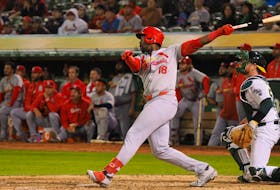It was in 1996 that Earl Woods, father of Tiger, proclaimed haltingly and through tears that his son, then just 20 years old, “would bring to the world a humanitarianism which has never been known before.” He also said the “world would be a better place to live in, by virtue of his existence.”
It was quite the agenda for someone embarking on a career as a professional golfer.
And while Tiger did not manage the messiah feat that Earl predicted, one could be forgiven for wondering, after the first decade of his career, if he didn’t have a touch of immortality about him after all.
He won on the PGA Tour as soon as he turned pro, and then crushed the field at Augusta National to win his first Masters at just 21 years old. He won four straight major championships from 2000 to 2001 and over those two seasons he won 17 PGA Tour events. Phil Mickelson, one of his most accomplished rivals, has never won more than four times in a season. Woods became the only player in history to win eight tournaments in a year three different times by his 2006 season. He was still just 30 years old. He had already won 10 majors by that time, and it seemed he would cruise to at least another 10 to pass Jack Nicklaus’ record total of 18. He did this while becoming one of the most famous people on the planet, an athlete who had more attention on him and interest in him than few others in history, owing in part to his accomplishments and in part to his ethnicity that had roots all over the globe.
No one had been hyped like Tiger Woods. And he had somehow lived up to it.
The road from immortal to all-too-human proved to be brutally short. Woods’ single-car rollover on Tuesday morning in California, which left the 45-year-old with serious leg injuries requiring long surgical procedures, was the latest reminder of this fact. He’s a guy whose accomplishments on the golf course remain remarkable, who changed the sport like no other before him, but who was also just a middle-aged dad who lost control of his vehicle and was lucky to escape with his life.
There is always more to a superstar athlete than the public persona we are allowed to see. Michael Jordan was seized with a relentless competitiveness, and even as he was a smiling pitchman he nursed an inner fury that drove his basketball success. Diego Maradona battled addictions even at the height of his soccer prowess. The list of flawed baseball stars is as long as a Barry Bonds home run into San Francisco Bay.
But no one’s shield of greatness has been dropped to expose everyday foibles as completely as Tiger Woods. For all that he did in that first decade on the golf course, culminating with a U.S. Open win on a damaged leg in 2008, he has been utterly, relentlessly human since. There was the fidelity scandal of 2009, in which an extremely private athlete had the details of his broken home life spill in waves out into the public. That was when Woods held a televised press conference to issue a robotic apology to those around him and vow to be a better man. There were injury problems, and more injury problems, and in his prolonged absences a more complete picture began to emerge of someone whose freakish greatness had been achieved at the cost of something close to a normal life. Earl had set out to raise a golfing machine and on that score he had succeeded. But with his death in 2006, Tiger was unmoored. He sought out intense Navy SEAL training in some kind of connection with his late military father, his marriage fell apart, his golf career would go through fits and spurts for years. Injury layoff, comeback, slow return to good form, injury layoff again. An impaired-driving charge, connected to painkillers he was taking after back surgery. Former members of his inner circle, of which there are legion, suggested that Woods had pushed his body so hard that he had effectively sabotaged his own career, like a rubber band stretched to the breaking point. Approaching his 40th birthday, his back was so damaged that he fell over from the pain while practising in his Florida backyard. He would later tell Time magazine that he remained on the ground, unable to move, until his daughter, Sam, found him lying there. He said at the time that his career might be over. He had won 14 majors in 11 seasons, and did not win another in the following decade.
Woods did author one more comeback. A surgical procedure relieved the nerve pain in his back and he worked his way back into playing shape. The intimidation factor of Peak Tiger was long gone, but he said he was just happy to be healthy and playing again. When he finally won that 15th major, at the 2019 Masters, his vulnerability was there for all to see. He hugged Sam, and his younger son Charlie, and the tears came easily. He would say afterward that he was just glad that his kids had witnessed golf bringing him something other than pain, struggle and disappointment. Tiger Woods had never been so relatable.
For a short moment on Tuesday night, with the images of his destroyed courtesy car, the fear was that his story would have an awful end. Instead, Woods is recovering. Although early reports on his injuries are grim . It will be some time before we know if he has one more comeback left in him.
Postmedia News
Copyright Postmedia Network Inc., 2021








